A New Home for the Spitfire Design Team
As in the First World War, the now Dowager Lady Cooper offered Hursley Park House for use as a hospital, but this offer appears to have coincided with a requisition placed on the Park by Lord Beaverbrook, the then Minister for Aircraft Production. After his order to disperse Vickers operations was made, he issued an edict for the immediate requisition of the fourth floor of the Polygon Hotel in Southampton to accommodate the executives of the company. The design team was housed at Southampton University until they were again firebombed out of these offices. In December 1940, they were all moved to Hursley House, which formed a suitable self-contained area for the Supermarine administration.
Although a number of Lord Beaverbrook’s personal staff moved down from London to assist in the whole complex operation, which spread over many counties (with manufacturing and assembly of Spitfires around Eastleigh, a new factory at Castle Bromwich, and facilities at Newbury, Reading, Salisbury, Southampton, Trowbridge, Winchester, and the Westland Aircraft factory at Yeovil), it was really Len Gooch, then aged 30, and some able administrators who were the driving force behind the expansion and production of Spitfires at that critical time. Lady Cooper, in spite of having her offer countered by the requisition order, and obviously feeling overtaken by events and their overwhelming impact on her stately home, with nearly all control this time out of her hands, graciously welcomed her new guests with a spectacular floral model of the Spitfire in the entrance hall of the House. The accommodation of the design and administration staff required the storage of most of the furnishings, paintings and fabric that made up this country mansion. For a time Lady Cooper continued to live on the first and top floors of the House, and was supported by a few staff. The staff were also useful to Vickers until June 1942, when it became impractical from a security standpoint to continue with this arrangement, as the following account shows.
On 19 June, several of the Supermarine staff returned from a cricket match and were surprised to discover fire engines in attendance outside the House. It transpired that Mr Grove the butler, being short staffed, had taken on a casual assistant cook, who was tempted by an opportunity to steal the family silver stored in a safe in the basement. His aim was to start a fire on the top floor above Lady Cooper’s bedroom, to divert attention away from the scene of his nefarious deed. His plans went awry due to the substantial reinforced concrete between the floors, and he was somehow overcome by the smoke from his own decoy fire. After investigation by the Police, a bicycle went missing from the village several days later, and the man was not seen here again.
This incident highlighted the problem of security, and Lady Cooper, together with her staff, moved out to Merdon Manor Farm, little knowing that she was ending two hundred and twenty years of private residential use for Hursley House. A former C.I.D. officer from Scotland Yard, a Mr Wakeling, was taken on as security officer, and is remembered for always wearing a black suit and black homburg hat which he was never known to remove.
Evidently Scotland Yard considered their men improperly dressed if the hat was removed. This custom dated back many years and helped cultivate the stereotype image of a, Scotland Yard detective. For a time he lived in one of the cottages that made up the bothy by the stables, and had his office at the top of the House. From this time Vickers Supermarine completely occupied the House, stables and cottages, and started the building of the two large hangars. The one to the east of the House was the drawing office, known later to IBM as X Block (demolished in 1994) and the other, adjacent to Southampton Lodge, was the experimental hangar. (This was demolished in 1986.)
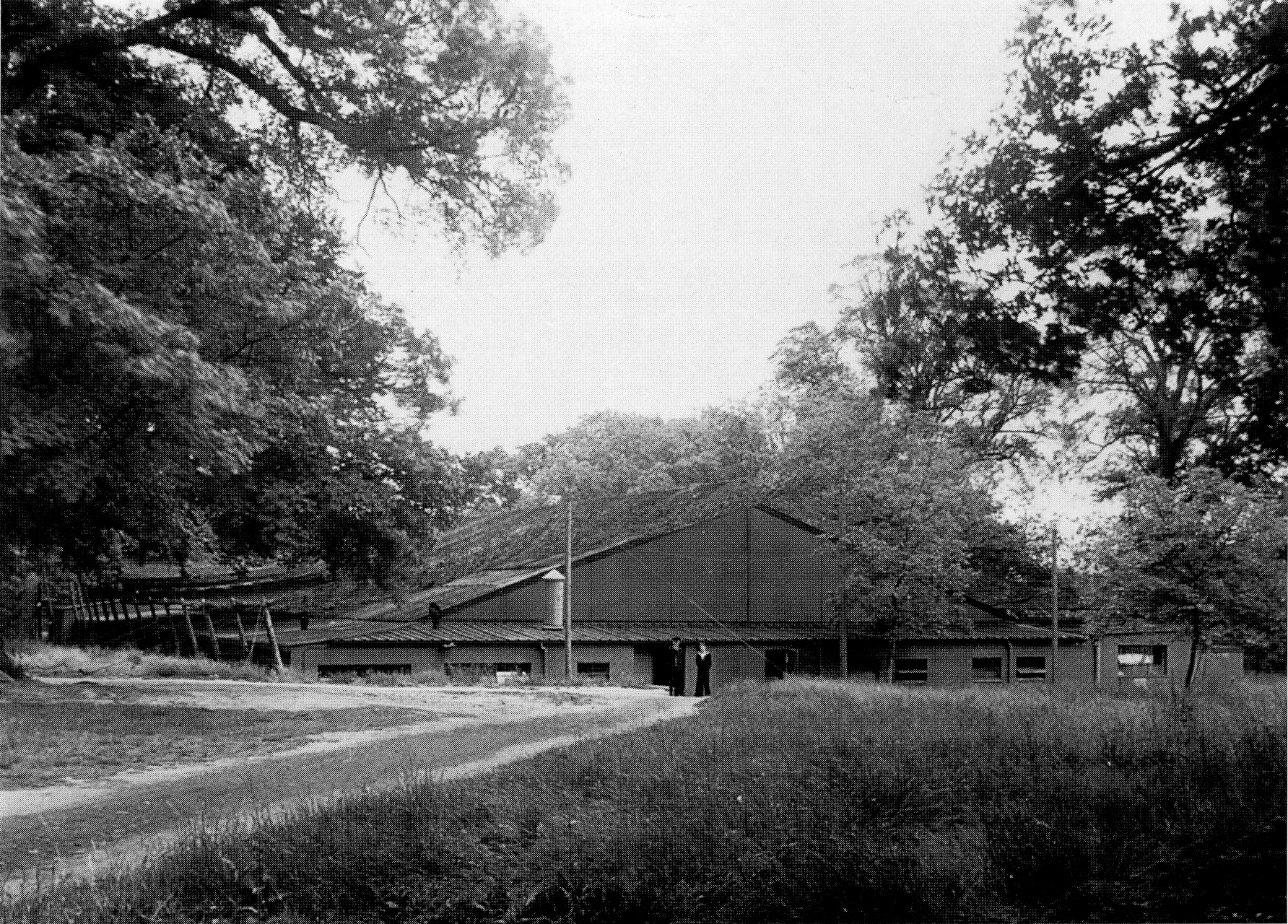 Drawing office from the north west. Photo: Cambridge University Library.
Drawing office from the north west. Photo: Cambridge University Library.
Initially around fifty people came to Hursley, soon to swell to several hundred as others were recruited from all parts of the country for their various skills and abilities suitable for experimental factory work. A fairly large group of printing operators were conscripted from the Bournemouth area, as were workers from the Midlands and North of England. There were solicitors, professional footballers, novelists, and retailers in this very mixed bunch. The few with manufacturing experience and skills in all—metal aircraft were made chargehands or foremen to train and educate the rest in the latest technology. The hours at work were long — in excess of eighty hours a week were often the case. If individuals were persistently late or absent from work, they would be hauled before a tribunal to account for their behaviour, and could be prosecuted and called up for service. One young man served a month in Winchester Prison, before being immediately conscripted to the Air Force. A number of workers were ‘dereserved’ and Within days found themselves in uniform. Some preferred this to factory life to which they could not adapt.
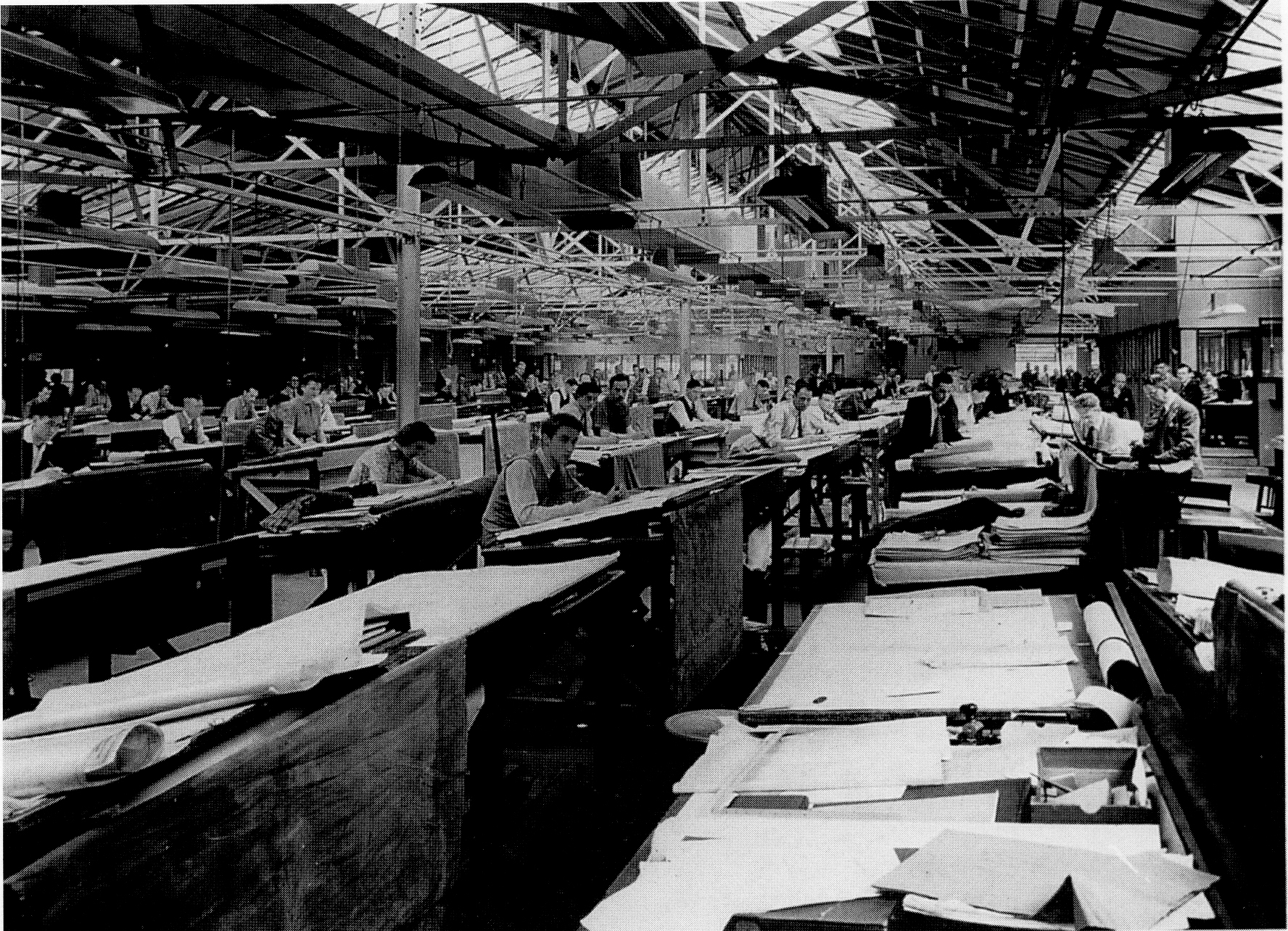 Drawing office interior. Photo: Cambridge University Library.
Drawing office interior. Photo: Cambridge University Library.
Mr Wakeling is also remembered by some of the senior executives for organising a trip to London to sample some of the night life, of which he seemed to have expert knowledge. The unorthodox methods he used to gain entrance to'some of the clubs were an eye opener to those otherwise unblemished lives who had never experienced such goings-on. He also kept an eagle eye on those members of the design staff who raided the walnut trees in the Park, until some of the staff who were working through the night found him collecting walnuts in his famous homburg - an incident he was not allowed to forget. The design staff generally considered Wakeling to be under employed, and invented cases for him from time to time. One of his longest was investigating the theft of Joe Smith’s imaginary bicycle.
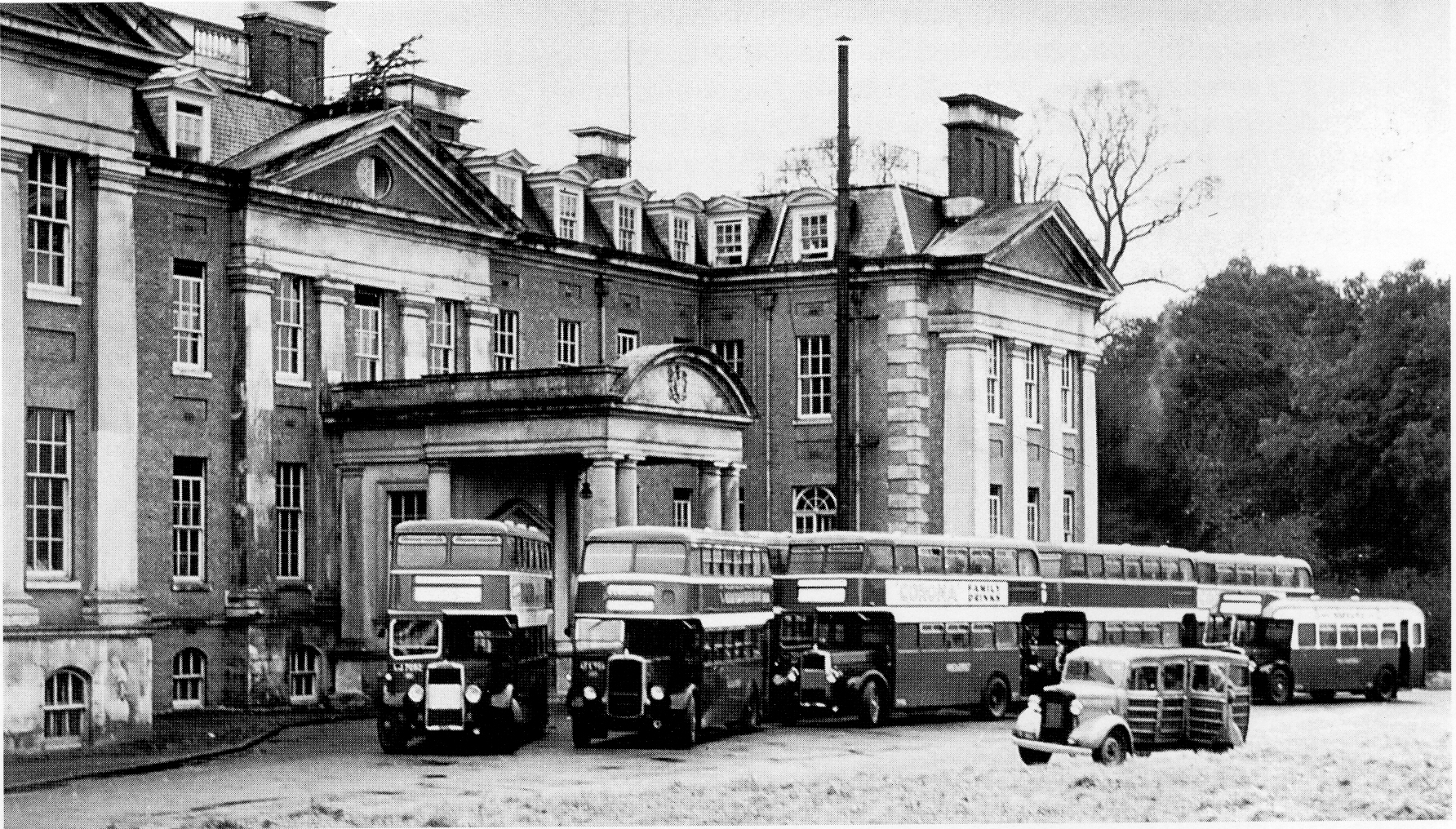 Buses outside Hursley Park House. Photo: E B Morgan.
Buses outside Hursley Park House. Photo: E B Morgan.
Most of the Supermarine staff were bussed into Hursley Park each morning and home again in the evening. The bus rides are remembered with measures of enjoyment and trepidation. Some of the Supermarine folk acted as conductors, and each bus had its card—playing contingent on the top deck. In the early days, Hursley Coaches, owned by the Jones family, had the contract to bus in Vickers staff, and one of the Jones brothers is remembered for taking his hands off the steering wheel to unwrap a sweet slowly and methodically before putting it in his mouth.
Later, staff numbers increased and local bus companies had to be brought in to assist with the extra numbers. The drivers, used to more normal stop and go routines to match the bus stops, had to adjust to a 16 mile non-stop trip. There were often two buses running neck and neck up the Chandler’s Ford Road to try to get to the ‘S’ bend first. By contrast, there were foggy nights when two passengers walked in front to lead the bus along the Woolston to Netley portion, making that a long, tedious trip. One evening a design staff member fell asleep in the washroom, missed his bus to Eastleigh, and had to, wait until midnight before a Supermarine driver was able to give him a lift home. Only the most senior staff had the privilege of motor cars, with the essential petrol coupons to run them.
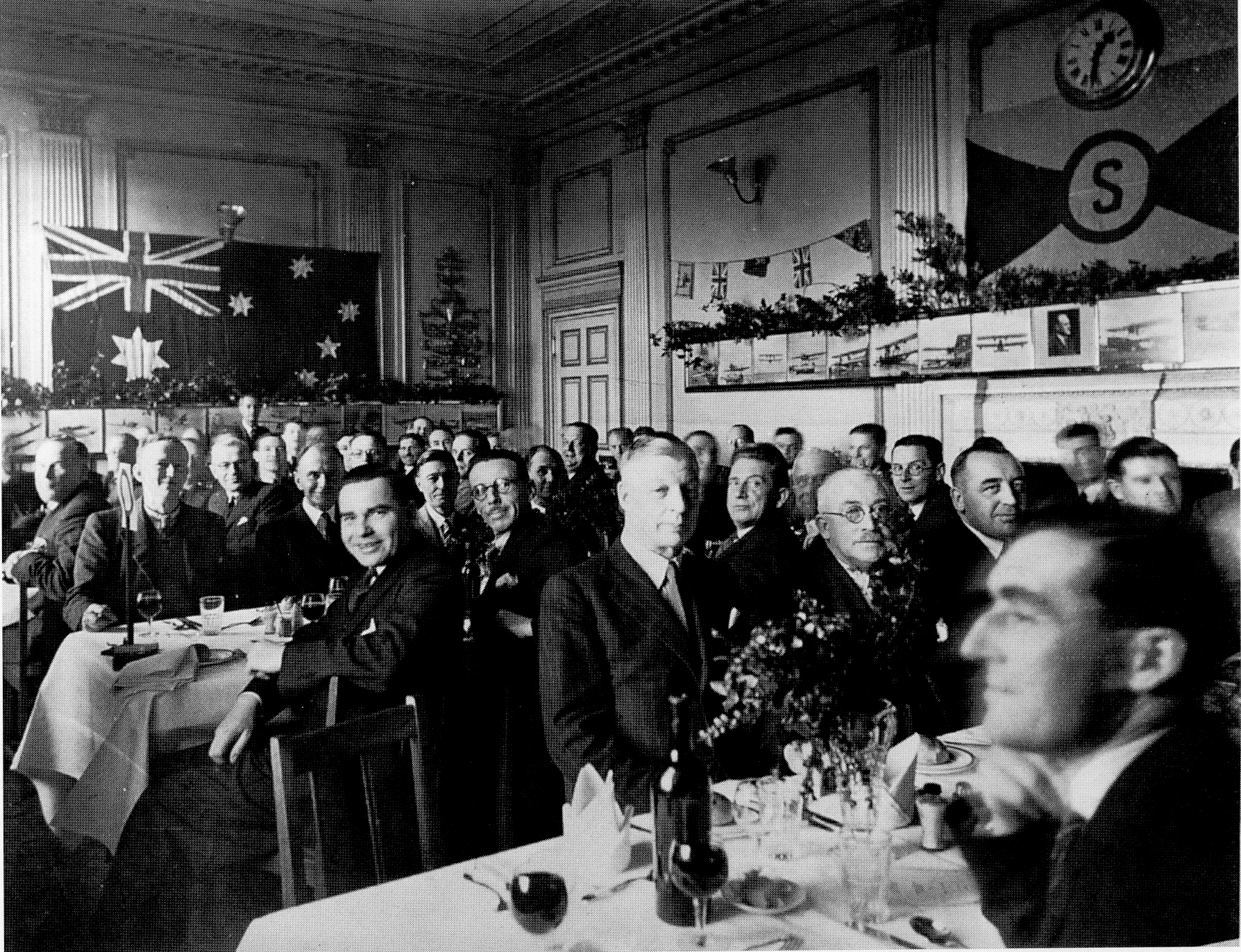 Executive staff Christmas lunch. Photo: C R Russell.
Executive staff Christmas lunch. Photo: C R Russell.
Reg Turley, the canteen manager, had been recruited from Lowman’s the Bakers in Southampton. He was in charge of the provision of daily lunch requirements. There were two lunch sittings and two dining rooms. The principal dining room was reserved for senior members of staff. There the difference was more evident in the decor and aperitifs than in the food. This two-level system was the norm in British Industry at the time.
Between the years of 1940 and 1957 the rooms of the House were used for many purposes, and here is a brief description of some of their various functions and uses starting with the lower ground floor:
The original wine stores provided cool, dark facilities for the photographic department, before their eventual move into the stable 10ft, headed by a Mr Burr.
Successful communications were essential to the Supermarine management and the telephone exchange was a vital link between the dispersal units. They also provided a direct line to the R.A.F. so that a member of the Observation Corps here could monitor the movement of enemy aircraft.
Mrs Edwards was Lady Cooper’s cook, and several of the Supermarine staff, when required to work all night to solve urgent problems, were thankful for the constant supply of her renowned ‘stock pot’. Another revered cook was Mrs Cocket, who prepared supper for the handful of design staff on fire- watch duty every night. She could work miracles with a potato, a bit of cheese and some dried egg.
The metallurgical laboratory was initially housed in the former linen store where the numerous cupboards provided storage for their many chemicals.
On the ground floor the rooms were used as follows:
The library contained a wealth of books and was kept locked for the period that Lady Cooper lived on in the House. Later, this room was taken over by the technical library which provided the Supermarine staff with a most valuable service when they were involved in recording alterations and improvements to the wartime aircraft.
The ballroom and winter garden (conservatory) were the original quarters for the design staff, but as this team expanded it was necessary to build additional accommodation in the Park. By the end of 1941 a purpose-built drawing office (X Block until 1994) together with five prefabricated huts were erected to the east of the House, affording easy access to the executive staff via the conservatory. The first hut was used by the electrical design team, the second one was home for the technical publications department under Gerry Gingell.
The flying boats design team under the direction of Harry Phillips was housed in the third hut, which was next to the layout and model shop after they had moved across from the stable loft. The end hut was used by the hydraulics design section. Approximately 25 to 30 staff were accommodated in each hut. The huts are remembered for being excessively cold in winter and hot in summer.
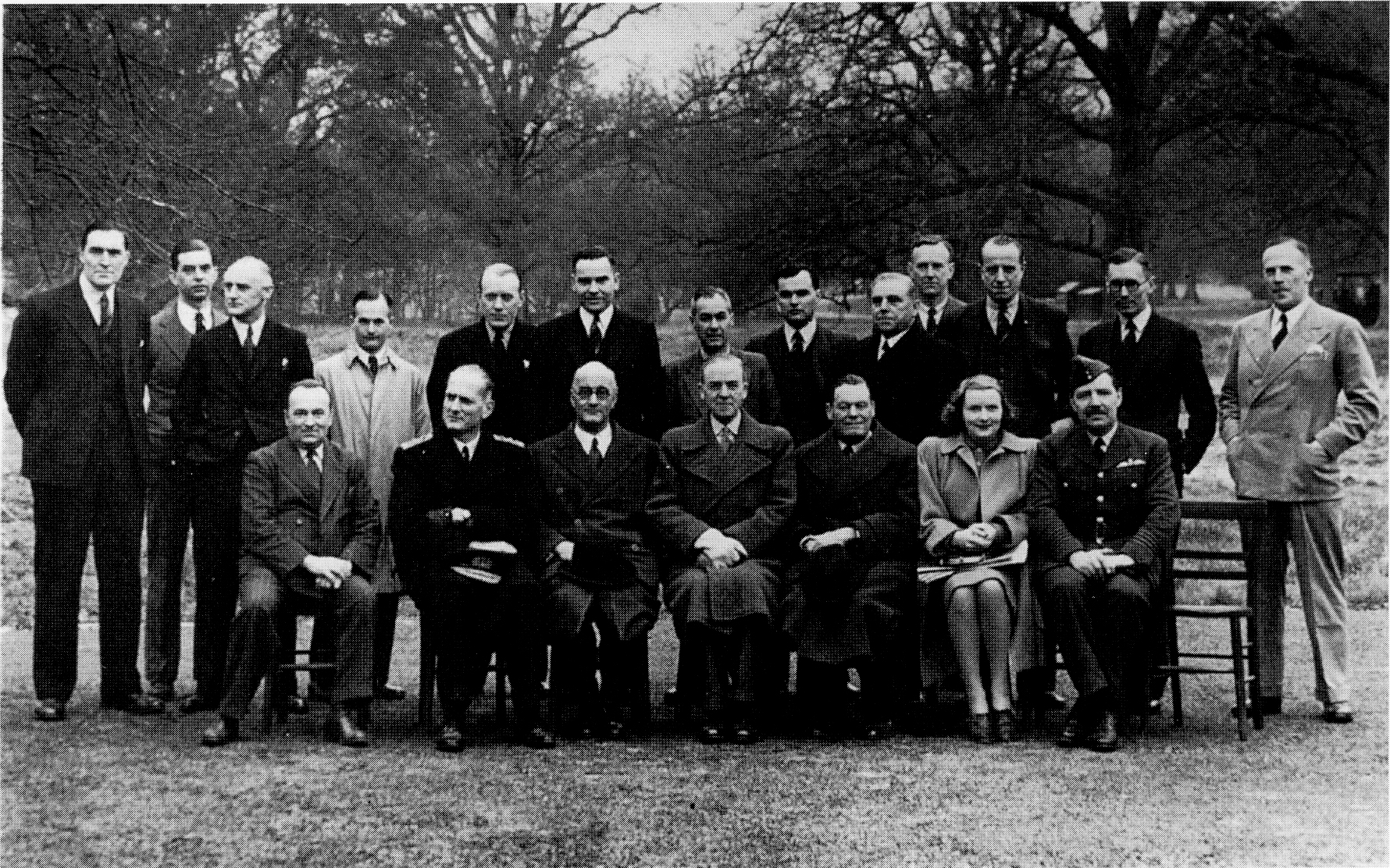 Vickers senior staff group, with Sir Stafford Cripps (seated third from left, front row).
Vickers senior staff group, with Sir Stafford Cripps (seated third from left, front row).
Joe Smith, the chief designer and natural successor to the designer of the Spitfire, R J Mitchell, had his office in the former business room, with a view across the sweeping lawns to the south. He was a man respected from the shop floor upwards, and although he would never claim Mitchell’s genius, he was without doubt the right man to head the Spitfire’s development.
The executive dining room differed from the mess rooms, and in addition to their staff lunch they were provided with a bottle of beer. The then Duke of Kent was one distinguished visitor to be entertained here shortly before his death on 25 August 1942. For his visit, the maintenance department tried to spruce up the surroundings, but discovered each piece of restoration required considerably more time and effort than first envisaged. (The present Duke of Edinburgh visited Hursley Park on Friday 17 April 1953, accompanied by the 17 year old Duke of Kent. They toured Chilbolton where they witnessed a demonstration of the Supermarine Swift, piloted by Dave Morgan, and after visiting Hursley Park design offices and the Experimental Hangar, ended the tour at the South Marston Works. Sir Stafford Cripps also got the VIP treatment when he visited Hursley Park, with everything being made smart and tidy for the occasion.)
After Lady Cooper vacated the House, her suite of rooms on the first floor was occupied by the Commercial Manager, the Production Manager, Personnel Manager and their secretaries. The former William and Mary bedroom was allocated to Commander Bird, the general manager, and the office of overseer was occupied by Group Captains Perkins and Thompson at different times in the Cromwell Dressing Room. Other rooms, including the Chinese Bedroom and the Azalea Bedroom were used to accommodate the Shipping Office and the Technical Publications Department. Unfortunately, during some maintenance and refurbishment work the wallpaper in the Chinese Bedroom Was thought to look shabby, and was consequently given a coat of paint. The maintenance staff had not realised that it was silk.
One resident Technical Officer, Kenneth Knell, who was also a pilot, and his assistant Stuart Mosey established a reputation for opening many doors to establish important business contacts and overcome obstacles, a gift shared by Arnold Hall, who later became Sir Arnold Hall and Chairman of Hawker Siddeley Aviation. Stuart Mosey also went to Hawker Siddeley at Hamble but as Resident Technical Officer.
 Aerial photo of site.
Photo: Cambridge University Library.
Aerial photo of site.
Photo: Cambridge University Library.
In a bid never to be caught again with drawings so easily destroyed by fire, the garages and coal store were re-roofed in massive reinforced concrete to Withstand incendiary bombs, and this provided a secure drawing and document archive as well as some offices.
The stable block provided very useful accommodation and a Belman hangar was constructed in the courtyard to house facilities, including hydraulics for experimental work there. In one corner was an inspection pit with a gimbal arrangement above to enable the testing of fuel system flow rates encountered at certain altitudes and tilts.
The metallurgists had a test building where they could inspect materials daily for changes in appearance brought about by stress and corrosion. This building stood approximately where the present radio frequency interference facility is to the south west of the House. This building was simply a low corrugated steel roof supported on an angle- iron frame, with no sides. The chemical, metallurgical laboratory and photographic department were moved to the ground floor of the stables when they were vacated by the model shop. Subsequently the photographic activity was moved into the loft to make room for a test facility covering hydraulic, electrical and fuel systems which was later expanded to take in part of the Belman hangar where the gimbal pit was provided. The area between the hangar and the stable block was roofed over to house a high-altitude test chamber with its associated pumps.
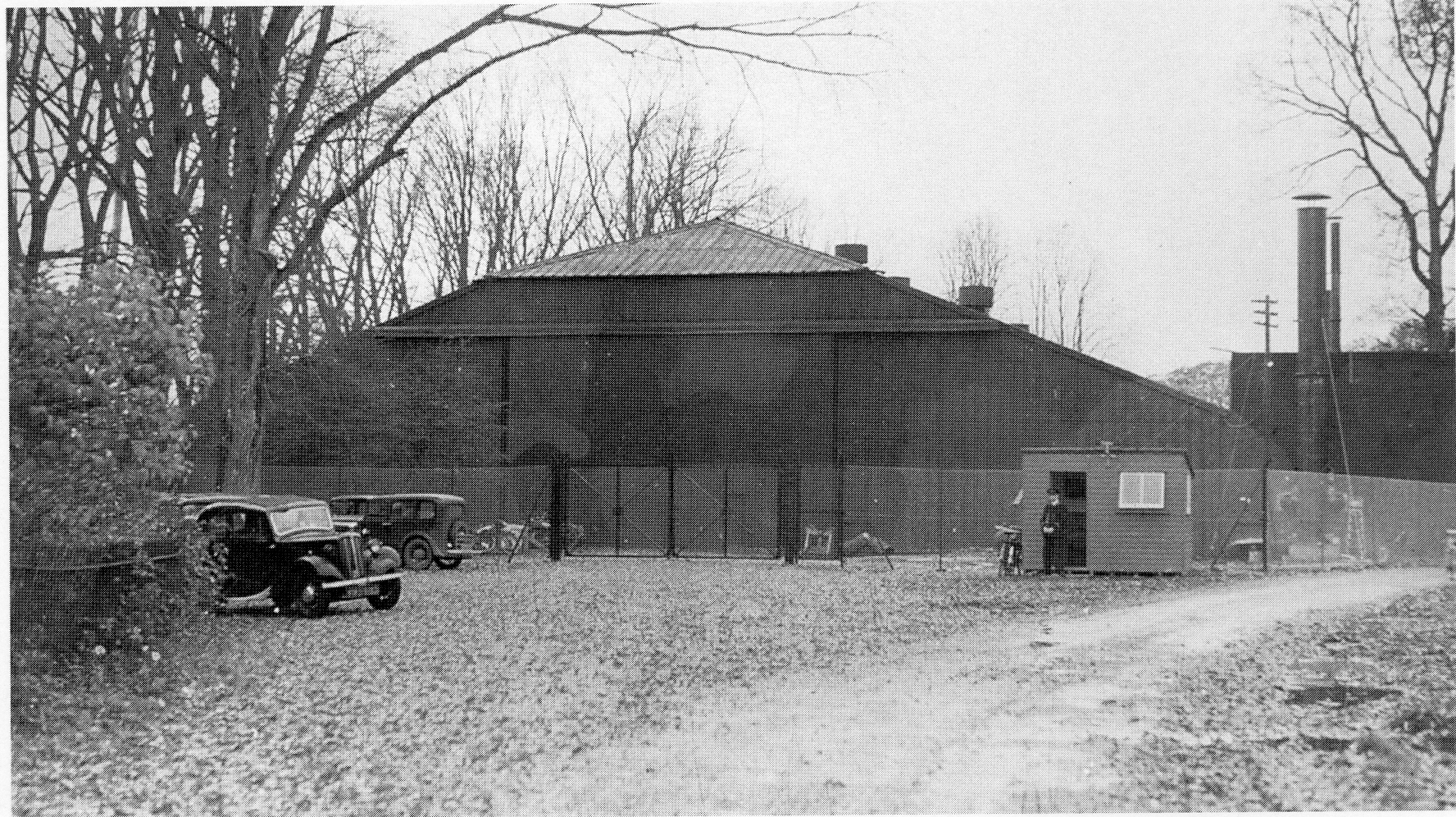 Experimental hangar from the east. Photo: Cambridge University Library.
Experimental hangar from the east. Photo: Cambridge University Library.
The entertainment hall that once stood behind the stables on the south side was used as a machine shop. It seems that oil from the machines soaked in and ruined the floor and vibration made the walls unstable. For the once immaculate hall, this was a sad end to a dance floor which was considered to be the best for some twenty miles around. After Vickers’ tenure it was in such a poor state that it was demolished for safety.
Like the drawing office, the experimental hangar was rapidly constructed under a line of large trees close to the Southampton Lodge entrance in 1942, and enabled the _ experimental shops to be moved there from their makeshift accommodation in the stable block. This building expanded, with several extensions for a canteen and other facilities. This whole area enabled full sized prototypes and aircraft to be worked on with unaccustomed comfort. One characteristic of working here was the effect spilt hydraulic fluid had on crepe-soled shoes, much in vogue at the time, as it caused the sole to expand to almost double the footprint.
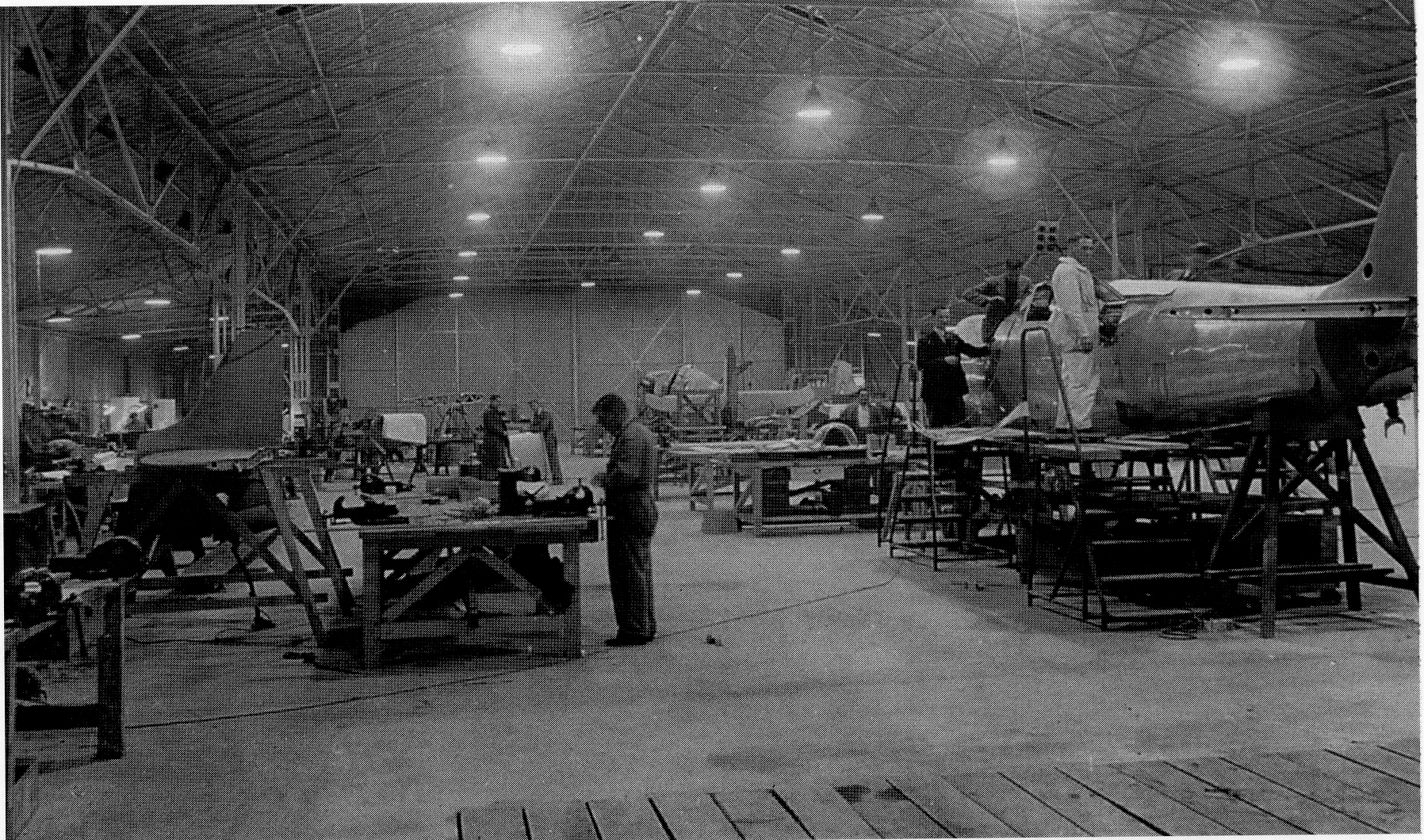 Experimental hangar interior. Photo: Cambridge University Library.
Experimental hangar interior. Photo: Cambridge University Library.
The building to the east of the House was the drawing office, a use that continued for a while with the new tenants (IBM) from 1958, and was still remembered by those with more than twenty years of service with IBM in 1990. There was a hangar-type building near or where the present RFI laboratory stands. This was used as a mock-up shop for the Attacker aircraft. By necessity, the administration spilled over into the village, and other Cooper properties were taken over. Southend House, for example, acquired some prefabricated huts in the grounds, to accommodate the whole accounts section in quite an efficient operation, although the way the wage packets were carried through the Village to the House and experimental hangar, would today cause even the mildly security conscious to break out in a cold sweat! As aircraft production receded in the post-war period, the Vickers organisation began to discuss plans to relocate their personnel to South Marston, near Swindon, Wiltshire, a move which Joe Smith and others strongly resisted, and it was only after his death on 20
February 1956 that Vickers finally undertook the controversial move from Hursley. A number of people did not relish moving to Swindon and left the firm, others tried the move but did not like it and left. The accompanying photograph of hooded pall— bearers carrying the coffin of ‘Vickers Armstrongs Supermarine Hursley Park’, at a company social function of the time, eloquently sums up the feelings of the Hursley staff.
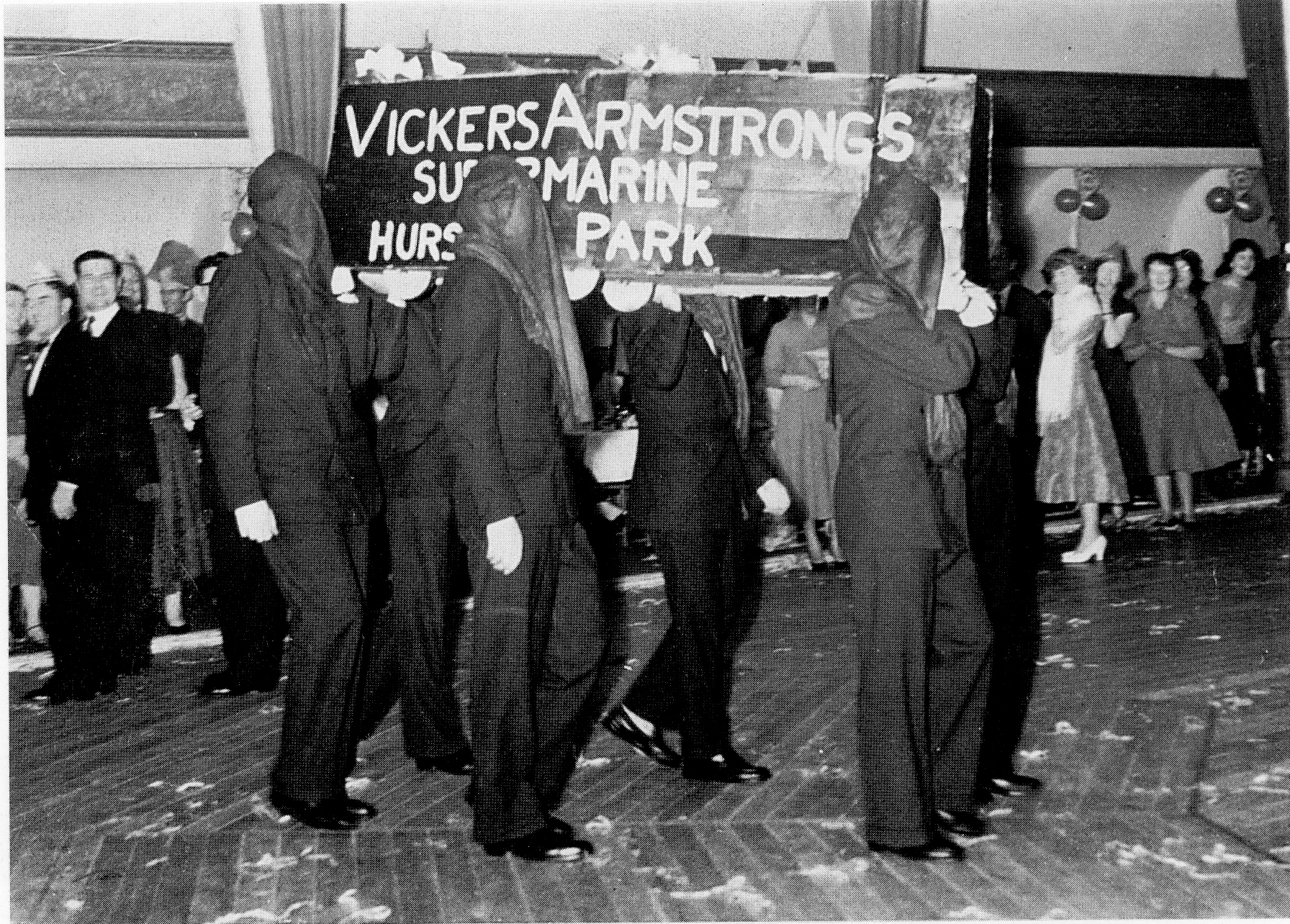 Pall bearers making a point. (The Pier Ballroom, Southampton). Photo: C R Russell.
Pall bearers making a point. (The Pier Ballroom, Southampton). Photo: C R Russell.